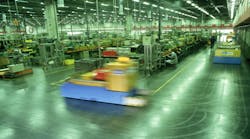The iconic Converse and Hurley brands share two distribution centers in Ontario, Calif., accounting for a combined footprint of one-million square feet. Yet across the several miles that separate them, the facilities have automated and synchronized their entire wholesale, retail and eCommerce supply chains so they are scalable, functional, flexible and quick.
Converse has paved the way for more efficient material handling processes. It has cut two days off the retail order-processing timeline and lowered its cost per unit by 20 percent—all while processing as few or as many orders as needed per day.
The Converse way is a portent of things to come across the supply chain.
Here are some other trends sure to capture the attention of material handling and logistics executives over the coming months:
Omni-channel to be Omnipresent
Since 2012, many manufacturers have moved into eCommerce, i.e. selling direct to consumers, while continuing to service retailers. eCommerce has disrupted many of these manufacturers, causing them to transform equipment and processes designed to ship pallet loads to warehouses, distribution centers (DC) or stores into mechanisms that ship as little as one or two items to a broad range of individuals.
The next evolution becomes more complex—and requires even more automation. It looks like 2014 will be the year of the omni-channel, a distribution system that promises to deliver products whenever, wherever and however customers want.
Pieces of an omni-channel mindset are already in place—indeed, 10 percent of retailers have invested in it for three years or more, according to IDC Retail Insights. In addition to the customary “direct to consumer” eCommerce, retailers such as Best Buy and Guitar Center offer options that allow customers to purchase non-stock items online and have the orders shipped to a local store location for customer pickup in a few days. Some even allow customers to order online out-of-store inventory for same-day pickup.
The omni-channel approach takes this concept one step further. For example, customers can order online and have a product shipped to their homes the same day, either from a brick-and-mortar store or a local warehouse. Additionally, customers can make in-store purchases of out-of-stock sizes or colors, and subsequently have the proper products sent with same-day delivery to their homes or preferred stores. Some retailers are already starting to deploy Directed Order Management (DOM) systems that review the inventory in stores and DCs, and then decide on the optimal location to send the orders. In effect, every link in the supply chain becomes connected to every other link—including the customer. IDC predicts as many as 50 percent of national retailers will invest in DOM systems by 2016.
Although the omni-channel is an incredible boon to customers, it presents some significant challenges to manufacturers, distributors and retailers. The first is inventory management.
It has become more important than ever for retailers to have a single view of inventory rather than keeping it in online and offline silos. Customers who make online purchases for store pickup expect those products to be waiting for them at the store. If the eCommerce site can’t access the store inventory in real time, it is possible that a customer could order a product that A) is unavailable in the store because the last one was already sold; or B) is unavailable because it wasn’t taken out of store inventory when the customer placed the order, resulting in the product being sold after the online order was placed and confirmed. Either way, you have an unhappy customer.
With a single, consolidated, real-time view of inventory, the manufacturers, distributors and retailers all know exactly where every SKU is all the time, making it far more efficient to fulfill every order, no matter its point of origin or its destination.
The other side of that efficiency is the need for more automation than many organizations support. Omni-channel selling introduces a level of distribution center complexity at a time when customer demands are becoming more extreme. Taking “one of these, two of those and five of the other,” placing them in a carton, and getting them to any of millions of possible destinations is far more difficult than shipping pallets to a DC, or from a DC to a retail store.
The sheer number of variables alone makes this type of omni-channel fulfillment extraordinarily challenging. Technologies such as pick-to-light/voice, AS/RS, software-controlled sortation, and robotics can speed up fulfillment while increasing accuracy. Software that automatically gathers real-time data that assists with redesigning storage locations to reduce travel times and/or the number of trips required to pick high-volume SKUs will become more valuable as well.
The first forays into omni-channel fulfillment are already being made. While it will start as a competitive advantage, we’re predicting it will quickly become standard practice. By the end of 2014, organizations that aren’t already moving in that direction may find themselves struggling for market share—or relevance.
Automation Gaining Traction
There is a sea change happening right now in the supply chain as a shortage of skilled labor collides with higher productivity requirements. But as the economy continues its upswing, manufacturers are willing to invest in operational upgrades—namely automation—to solve these issues.
Though high unemployment rates have plagued the U.S. for much of the past six years, it’s no longer a pervasive issue. Some regions are boasting local unemployment rates as low as 4 percent, which makes it hard to find qualified workers for a flourishing business, labor management consulting company TZA said in a recent podcast. Compound that with the fact that the traditional DC workforce is rapidly aging out of the profession, and you’ve got a hiring crisis brewing.
But automation can take the workforce challenges out of the equation.
DCs have historically been difficult places to automate, with the variable size and shape of all the containers that must wind their way through. New technologies, however, including advanced, responsive vision systems and improved software are helping to solve some of the trials.
Though the dock is among the hardest places in a DC to work, for either human or robot, new 3-D vision systems allow manufacturers to automate the processes with ease, according to a recent article in Robotics Online. A robot can simply roll its way into a trailer and unload it, responding to different package shapes and fluctuations with the same grace as a human—and often more reliably.
Both the lower cost and higher productivity levels are turning automation into a distinctly competitive advantage—especially during peak demand periods that require a higher-volume output.
With robots, there’s little risk of injury as they rotate and lift. But even as robots fill human roles in the warehouse and DC, they create more value-added jobs for engineers and technicians who develop and execute the systems. It results in a win-win for the manufacturer who is working smarter and faster.
Big Data makes a Big Impact
As the material handling industry continues to seek productivity gains by moving from being mechanically based to computer controlled, one of the most important byproducts is an accumulation of data about its operations. Insights in that data can help organizations ferret out inefficiencies, make better staffing decisions, adjust work schedules and predict equipment maintenance requirements more accurately to keep the warehouse or DC operating at optimal levels.
Until recently, managing staffing requirements was more of an art than a science, based largely on the “gut feel” of a manager who understood the cycles of the warehouse or DC through years of service. While that experience brought great value, it was still more observational than evidence based.
With the data organizations accumulate through software-driven material handling systems, managers can now use facts about what is happening in the warehouse or DC to make more precise, information-driven decisions. They can also better accommodate peak and slow seasons. The result is the ability to drive out previously hidden inefficiencies, which reduce handling times and costs while raising customer service to new levels.
We are already seeing the benefits of Big Data analysis in maintenance. Typically, maintenance has been based either on an event, i.e. something breaks, or on the equipment manufacturer’s best estimation as to when a part should be replaced. Both of these approaches are primarily reactive and lead to unplanned downtime, which rarely occurs when you can afford it.
Some organizations have moved to a more proactive approach. They may train operators to look for signs that a problem is about to occur, at which point they either alert maintenance or resolve the problem themselves. The success of this initiative depends on how much the operators know—and care.
Other organizations may determine their own, more aggressive maintenance schedule. The problem with this approach is they might replace parts that still have a good deal of life left in them, which means they’re spending more on parts than they need to.
Big Data is providing a third alternative: a predictive approach based on information captured from working equipment. Suppliers of computer-based material handling equipment are starting to build large data stores of operational information. When it reaches a large enough sample size, these suppliers will be able to start predicting maintenance needs with far greater accuracy.
Take a bar code scanner. Rather than guessing how long it will perform at an optimal level, suppliers will have a large store of historical evidence that indicates when the scanner’s performance is likely to fall below acceptable minimums. A low performance metric (read rate) may point to the need for recalibration or replacement. Low performance could also point to label quality issues or problems with alignment or application.
All of these issues can be addressed quickly to improve overall system performance, therefore meeting the challenge of today’s fast-paced delivery requirements. The customer can then analyze the production schedules and determine when maintenance can be performed without seriously disrupting the operation. By using predictive analytics, equipment performance can be maximized, which saves money while reducing risk to the business.
Some of the many operational benefits that can be gained from system data analysis include:
- Identifying staffing imbalances;
- Understanding employee performance;
- Determining system bottlenecks;
- Forecasting performance and staffing requirements for peak seasons; and
- Validating and improving customer SLAs.
Keep these trends in mind as you chart your organization’s strategic course over the coming months. They can help you realize the goals of smoother operations and happier customers.
Clint Lasher is divisional president, engineering and integration, Oak Lawn at Wynright Corporation, a wholly owned subsidiary of Daifuku Webb and a provider of intelligent material handling systems. Lasher can be reached at [email protected].





